 April 2010
The Jimmy Awards for CES 2010
In five days at the 2010 CES, I gained seven
pounds. Like many people, when I’m bored, I eat. It wasn’t the hi-fi that numbed
my spirits as much as the walking, the waiting, the squeezing into elevators, the
navigating casino floors. After more than a decade of Las Vegas Consumer Electronics
Shows, I’m burned out by Sin City.
Besides, a hotel -- unless it’s a classic old
structure with flat floors and thick, solid walls, where a modicum of room treatment might
actually work -- is a lousy venue for high-end audio. At the Venetian Hotel, I heard not a
single system that sounded accurate when listened to in the farfield -- and most disserved
were those manufacturers that had shelled out beaucoup bucks for the Venetian’s
enormous meeting rooms. Although the soundstaging in such large spaces could be
impressive, the tonality, resolution, and timing were unacceptably smeared unless I sat
within a few feet of the speakers -- which defeats the purpose of having a big room.
To my ears, most demonstrations required a nearfield
listening spot, which is not my preferred distance. Sitting within 8’ of the center
point between the speakers doesn’t contribute to the illusion of majesty the way a
chair placed farther back does. As a result, the best sound at CES 2010 was not as
wall-to-wall spectacular as in years past, but listening in the nearfield at least negated
the early room reflections, and resulted in the most accurate truth of timbre and the
finest detail.
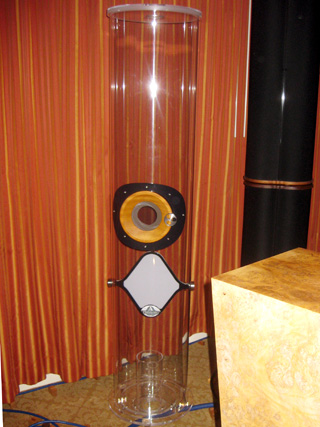
Polifermo
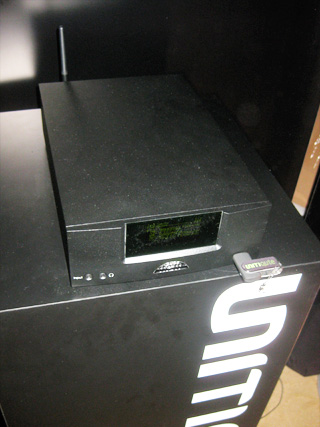
Naim
|
In ill-set-up systems, easy scapegoats were the choices of
source components. Many a digital front-end sounded congested or metallic; even the
gorgeous tones of vinyl were affected by the Venetian’s strange sunken rooms. Perhaps
manufacturers, especially of speakers, should consider frequency-shaping electronics to
overcome the hotel’s two-tiered dimensions. It’s telling that the most
convincing audio/video demo used a room-correction system. Audiophiles may pooh-pooh the
idea, but I think reflection-flattening electronics can give a truer picture of a
system’s merit than a pot-luck "purist" setup at the mercy of bad
vibrations. If digital technology can neutralize room effects without veiling, what’s
the big deal? I hope someone somewhere is working on software to serve a stereo system the
way Audyssey, for example, perfects multichannel sound. Let’s hope to see more room
correction at the 2011 CES.
The List
All prices are in US dollars.
16. I was so fascinated by Vincent Electronics’ Pangea
AC-9 power cord that, after the show, I bought one. This garden hose of a cord embodies a
lot of design lore, including multigauge geometry, counterspiraled conductors, double
shielding, and molded connector bodies, all of which I happen to like. A 5’ Pangea
AC-9 sells for under a hundred bucks -- but how VE can produce such a cord for so little
is a mystery. The "clean high-current power" it delivers was too much for my
amplifier, which lost control of my loudspeakers’ two 10" woofers. However,
feeding the preamp or CD player, the AC-9 was sweet and dimensional, and a vast
improvement over a 14-gauge generic cable. The Pangea AC-9 wins the first Jimmy
Award of 2010, for Best Accessory at the 2010 CES.
15. To paraphrase Woodrow Wilson’s Vice-President,
Thomas Riley Marshall, what this country needs is a good $1400 D/A converter. Bel Canto
Design has one! Their e.One DAC1.5 features a 24-bit/192kHz, dual-differential DAC with a
dynamic range of 122dB. It has balanced I/O, five digital inputs, an UltraClock, an
external DC power supply, a 24/96 USB input, an RS-232 port, a 1/4" front-panel
headphone output with independent DAC, a 24-bit digital volume control, and a remote
control. (Whew!) I’ve owned every DAC Bel Canto has designed, and all have been very
musical, at stellar prices. Although the e.One DAC1.5 was on silent display, I bet it will
mesmerize listeners for a very simple reason: It competes with recording-studio digital
processors at the same price. Continuing a sterling record of achievement, Bel Canto
Design wins a Jimmy Award for the e.One DAC1.5, for the Best Value
Digital-to-Analog Converter.
14. If room-correction electronics are outside your ken,
Acustica Applicata de Italia offers "your personal room tuner" -- the towering
Polifemo Variable Resonator ($7200 for two; four would be better). Unlike most acoustic
treatments, the Polifemo is tuneable, and smooths the most troublesome frequencies between
28 and 70Hz. It’s also snazzy in the Italian tradition, resembling a single-driver
loudspeaker in a transparent baffle. For making room treatment acceptable to anyone’s
missus (as long as she doesn’t see the bill), the Acustica Applicata de Italia
Polifemo Variable Resonator wins a Jimmy.
13. Although I have never used a real-time analyzer because
of the cost and technical skill involved, I believe any audiophile should have some idea
of how loudspeakers react to his or her listening room. Therefore, I was intrigued by the
possibilities offered by the Danish company Loudsoft. For the low cost of $300, their
FINESPL software enables anyone who owns a personal computer to measure room response.
With its huge math capabilities, the FINESPL is more a designer’s tool than a
hobbyist’s device, but at least two measurements are worth the layperson’s
attention: simulated anechoic measurements in-room, and SPL and frequency response with
phase. I suggest that anyone planning to exhibit at the Venetian for CES 2011 invest in a
laptop computer and Loudsoft FINESPL in order to "see" their setup. The Jimmy
Award for Best Audio Setup Software goes to the Loudsoft FINESPL.
12. For those to whom the terms streaming, iPod,
MP3, and USB storage mean anything, long-established British manufacturer
Naim Audio has the proper access device. Their UnitiQute ($1995) draws on the
company’s expertise in amplifier and preamp design to provide convenience technology
with hi-fi sound. The UnitiQute serves as a "digital hub" for game consoles and
digital TV as well as ye olde CD player. Computer files can even be accessed wirelessly.
Gamers considerate of the needs of others will welcome the headphone socket. For
introducing "new worlds of audio ripe for exploration," the Naim Audio
UnitiQute wins a JA.
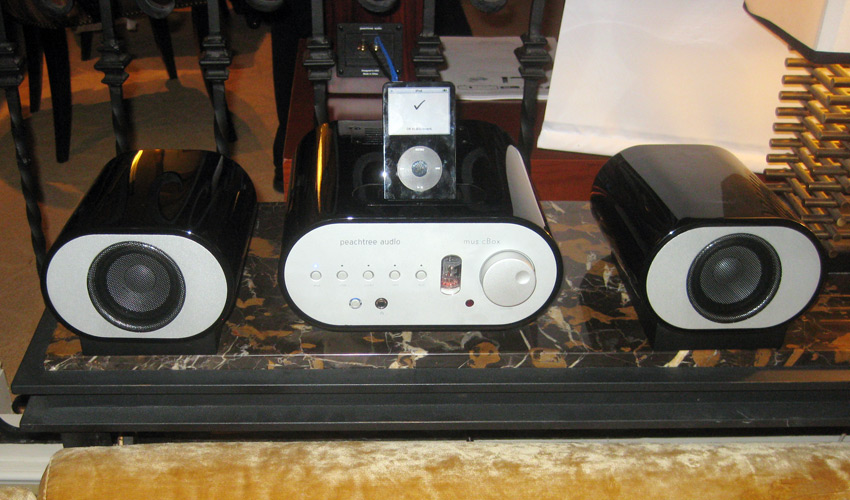
Peachtree Audio
11. If the Naim UnitiQute is a budget beauty, an even
easier recommendation for iPodists is the Peachtree Audio iDecco ($995). Billed as
five products in one, the iDecco contains an iPod dock, a 40Wpc integrated amplifier, a
tube preamp, a multi-input DAC, and a class-A headphone amp. The iDecco connects to
computer files via its USB port. Although its pair of analog inputs will probably go
begging, they’ll give comfort to owners of cassette decks. One may argue whether this
ingenious device indeed "covers the bases like no other product," but for CES
2010, the iDecco merits a Jimmy Award for Best iPod Component.
10. The motto of Sweden’s Bladelius Design Group,
"When silence matters," recalls my first high-end amplifier, the Octave Research
OR-1, which went silent so often that it mattered to my wallet. Bladelius, however, lauds
a less ominous state derived from a "silent playback system without any moving
mechanical parts." Although the sleek Embla source component ($9000) can be used as a
CD player, its higher purpose is music storage and playback via internal flash memory. The
Embla includes an analog preamplifier, a D/A converter from the company’s reference
CD player, and a "switchable digital filter with analog behavior." External hard
drives can be accessed via USB connection; you can stream music from a computer almost ad
infinitum. The Jimmy Award for Most Elegant Computer/Stereo System Interface goes to the Bladelius
Design Group Embla.
9. True confession: I could easily live with DALI
loudspeakers. In fact, the first-generation Helicon 400 is my all-time favorite in the
category of Speakers for Under $5000/pair. Unfamiliar to me until CES 2010, the
company’s two-year-old Lektor series is said to bring the Helicon experience to a
much lower price range. For experienced audiophiles who prefer the sound of paper drivers
to that produced by space-age materials, the Lektor’s lightweight cones of wood fiber
boast the longevity of polymers while suggesting the tone of paper. At $1800/pair, the
Lektor 8 is efficient (89.5dB), wideband (38.5Hz-27kHz), and well-lunged (112dB!). Better
late than never, the DALI Lektor 8 earns the 2010 Jimmy Award for Best-Value
Floorstanding Loudspeaker.
8. The Blue Light Special Jimmy Award goes to the mhi
Evidence minimonitor loudspeaker ($650/pair). Although some may question the
practicality of matching the low-tariff Evidence with a scazillion bucks’ worth of
electronics and power-line conditioning -- overkill beyond measure -- the results were
intriguing. I’m confident that the Evidence’s 2" aluminum ribbon tweeter
provides the basis for a great loudspeaker in any lash-up. The HiVi Swans 2.2Fs in my home
system sport a combo of ribbon supertweeter and dome tweeter that provides the most
detailed sound I’ve ever heard. The Evidence’s pairing of a full-range driver
and wide-range ribbon resides in a similar camp. I would love to mate the Evidences to a
Peachtree iDecco, then watch the face of the world’s richest audiophile, the Sultan
of Brunei, as he auditioned the system against his will.
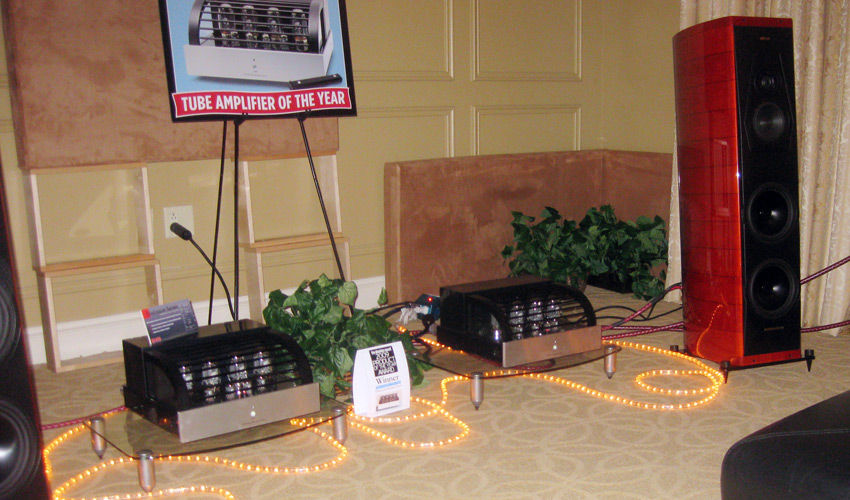
PrimaLuna
7. "Excellence is a habit, not a single act," say
the fine people at PrimaLuna. Another year and another Jimmy Award attest to the truth of
that statement. In terms of modern science, no other maker of tube amps provides so many
upgrades over a textbook design. Consider the following:
1) ProLogue Premium preamplifier ($2195): dual-mono,
choke-regulated power supply, tube rectification, subwoofer output, power-transformer
protection
2) ProLogue Premium stereo amplifier ($2299): auto-bias,
zero negative feedback, Solen caps, output- and power-transformer protection, bad-tube
indicator, 40Wpc
3) ProLogue Premium CD player ($3799): dual-mono,
choke-regulated power supply, tube rectification, the famous SuperTjoebClock, upgraded
op-amp board
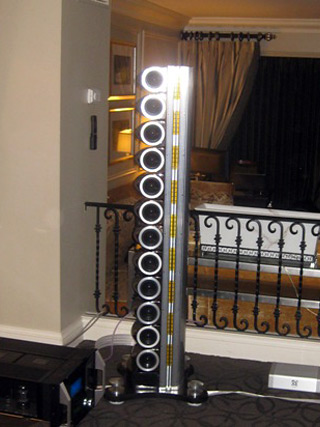
Scaena
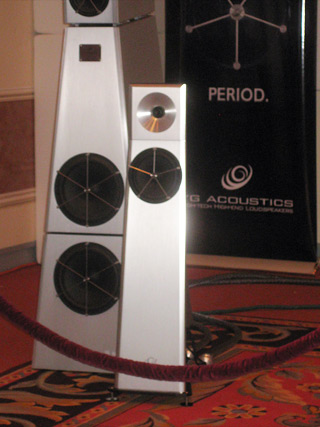
YG Acoustics
|
Such thoughtful technology not only provides great sound
but also protects one’s investment. The bad-tube indicator alone can save hundreds of
dollars in repair costs when blown glass boils a resistor. A Jimmy Award for Best
Technology in Tube Amplification goes to the PrimaLuna ProLogue Premium line.
There’s no competition.
6. Despite my populist stance on hi-fi prices, one
$50,000/pair loudspeaker so impressed me that I’d consider buying it. The Scaena 3.2
line array’s depth of image creates a virtual listening room in which the
performance "appears" much farther back than experience suggests it would be. As
with the Sunny Audio speakers of 2009, I was so taken with the effect that I neglected to
assess the truth of timbre, which I’ll leave others to judge. Also, a few years ago,
I was crazy about a line array from a design predecessor, Pipeline, that never quite came
to fruition. Nevertheless, I’ll risk my reputation as a golden ear by honoring the Scaena
3.2 with a Jimmy for Best-Imaging Loudspeaker at CES.
5. Among a few strong candidates for Best Sound at the Show
was the YG Acoustics room, where their new Carmel speakers were being demonstrated. At
$18,000/pair, the Carmels produced about 90% of the performance of YGA’s flagship
speaker, which sells for $107,000. I love that kind of math! My visit to the YGA room on
opening day alerted me that I might have already found the Overall Winner. However, when I
went back on the last day of the show, I was disillusioned: The YGA system didn’t
pass the MK Torture Test.* I suspect the room was to blame for a touch of lower-midrange
congestion; strategic room tweaking may have allowed the Carmels to conquer. Despite
missing the Best Sound Award, the YG Acoustics Carmel wins a Jimmy Award for Best
Trickled-Down Design.
* Mark Knopfler’s voice as he sings "Border
Reiver," from his new album, Get Lucky, challenges a system’s
midrange/bass crossover region. In a wayward setup, the words are veiled by low
frequencies. SoundStage! Network writer John Crossett, who supplied the music, said the
lyrics are intelligible through his loudspeakers, as they are through mine. But in most
rooms at CES, MK sounded as if he had lockjaw.
4. The Best New Amplifier Design goes to Audio Research
Corporation for their DS450 power amplifier. Unlike most hybrid amps, the
DS450’s input stage doesn’t include a tube. Rather, the amp mixes a linear
analog power supply with a high-speed analog switching MOSFET output stage. I guess such a
pairing qualifies as "hybrid." However, should anyone ask me what hybrid
means in this context, I’ll say: "A class-D amplifier that sounds as if
it’s a transistor amp with a tube in it -- a very big tube." Unlike most
switch-mode amps, the DS450 weighs a hefty 60 pounds and also puts out 450Wpc into 8 ohms.
The DS450 drove a pair of handsome Sonus Faber Elipsas ($20,000/pair), and the sound was
authoritative, with huge amplitude swings. I can’t wait to test the amplifier with my
"hybrid" ribbon loudspeakers. At $7995, even your faithful scribe can afford a
DS450, the Best Amplifier Value at CES. Wait -- that’s two Jimmys for a single
Audio Research product. Well, so be it. With so many rookies and charlatans hawking
overpriced wares these days, I think ARC should be honored for producing the Best Hi-Fi in
the World at a Fraction of the Price. That makes three Jimmy Awards -- and
counting.
3. So much has been written about the stupendous music and
video presentation in the Paradigm/Anthem room that I will add here only that I
never heard so much deep bass come and go so quickly. This room’s jump factor was by
far the most startling of any CES I’ve attended in 20 years. Anthem’s Statement
D2v preamplifier-processor’s room-correction software had a major hand in the effort,
enabling Paradigm’s setup experts to utilize the speed and power of their magnificent
six-driver Sub 2 subwoofer ($7499) without giving an impression of the bass having a life
of its own. After the mesmerizing demonstration of k.d. lang singing in surround sound in
the Paradigm demo, I’m almost ready to go multichannel in my music room. For the
second straight year, the Paradigm/Anthem room wins a Jimmy Award for Best Surround Sound
System at CES -- and maybe in the world.
2. When I first heard a Boulder Amplifiers demo,
five years ago at the old Alexis Park, I was underwhelmed. In 2010, I was in awe. The
nimble sweetness of the music in the Boulder room was as good as a digital solid-state
system gets. I attributed much of the effortless playback to the source component,
Boulder’s 1021 disc/network player ($24,000), which sent digital information directly
to the preamp without spinning a disc. I would love to compare the 1021 to the less costly
Bladelius Embla to see how the two technologies compare. The rest of the Boulder system
consisted of their 1060 stereo amplifier ($24,000) and 1012 preamp-DAC ($19,000), and
Focal Maestro Utopia speakers ($60,000/pair). The Boulder room was a friendly oasis for
the ears that I was reluctant to leave. Although I would never pay over $60,000 for any
stereo system, Boulder’s "entry-level" components comprise a much
better deal than some of the really expensive systems I heard and hated. The award
for Best Solid-State Sound at the Show goes to Boulder Amplifiers.
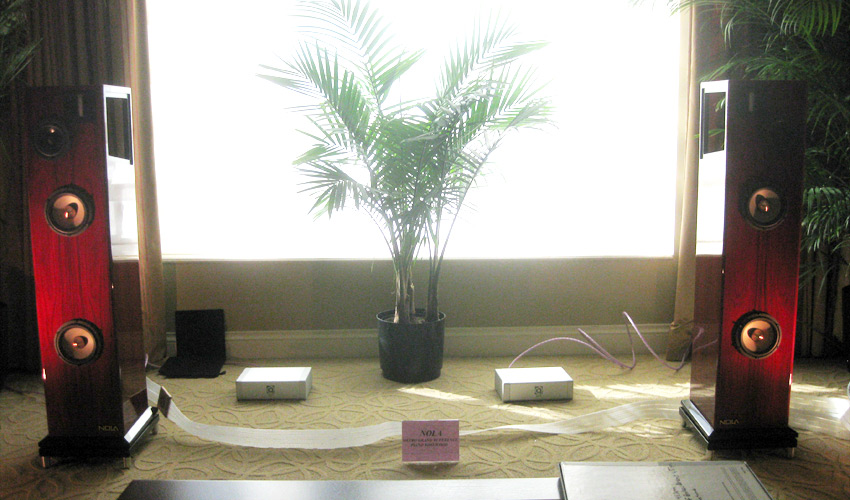
Nola
1. And now, the envelope please: The Best Sound at the Show
Jimmy Award goes to . . . Audio Research? Yes, in a way. That’s because
their fabulous Reference 5 preamplifier ($10,000), fantastic Reference CD8 CD player
($10,000), and first-class Reference 210 monaural amplifiers ($20,000/pair) were in the
employ of legendary loudspeaker designer Carl Marchisotto, in the Accent Speaker
Technology room. There, the new Nola Metro Grand Reference ($22,000/pair) produced
a sound to stir the hearts of angels. In mundane terms, the system’s airiness, truth
of timbre, and dimensionality provided a musical anodyne worthy of the River Lethe. The
system even breezed through the MK Torture test, which subverted many a demo. Is it
coincidence that the Metro Grand Reference uses a ribbon tweeter? As far as I’m
concerned, only ribbons can do treble with any semblance of reality -- and the
Metro’s champion alnico midrange driver is another ingredient of the speaker’s
higher resolution. Yet another crafty design feature is the use of a separate chamber for
each of the two bass drivers. Such isolation not only keeps the bass taut and tuneful, it
also negates midrange colorations. Attesting to Don Carlo’s acuity in exhibiting at
shows, the sweet spot in the Nola room was in the nearfield. A result of all this
expertise was that the Nola setup was the only one I heard that had no obvious need of
room treatments or frequency correction. The Nola Metro Grand Reference room deserves the
highest Jimmy Award: Best Sound at the Show.
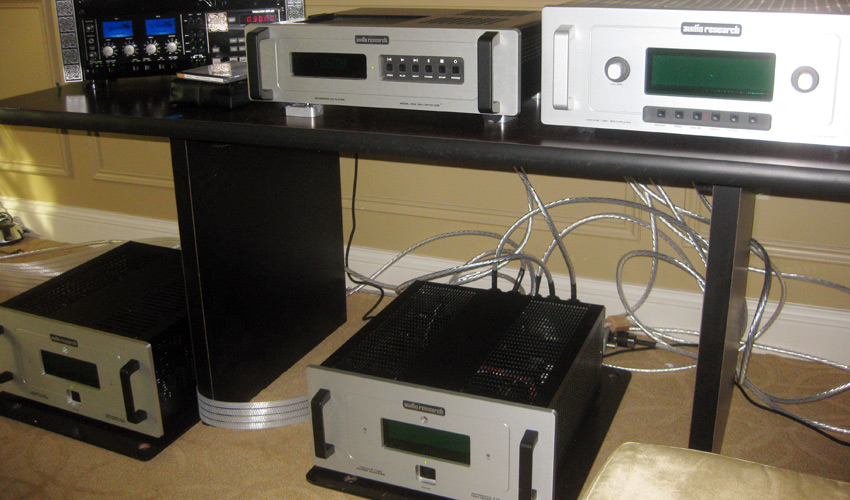
Audio Research's electronics
Addendum: Relative Value Award
As I shivered and cringed at this year’s hi-fi prices,
I recalled my days on Wall Street, where we traded bonds based on relative value. That is,
if similar securities were dissimilarly priced, we bought the bond that cost less and sold
the one priced higher. Too bad this sort of trading doesn’t work in the hi-fi market.
If it did, I’d buy blue-chip products that are fairly offered, and short-sell newbie
items bearing logic-defying price tags. For instance, an old-line company like Convergent
Audio Technology has for years offered one of the world’s best preamplifiers. Today,
their pedigreed Renaissance model costs $10,000 -- a lot of money, to be sure, but in
comparison to unproven (and perhaps underdeveloped) preamps selling for twice that,
it’s a bargain purchase. The same is true of reference products from Audio Research,
Naim Audio, Nola Loudspeakers, Anthony Gallo, Simaudio, and Bel Canto Design, to name a
few established firms that provide great value for money. Why pay as much as six figures
for a product with a short or no gestation period, when established high-end companies
offer excellent evolutionary designs for ten grand or less? I suspect it has little to do
with the music. To those audiophiles who appreciate the price/performance ratio of
a CAT Renaissance preamp, a Simaudio Moon Evolution amplifier, or an Audio Research
Reference CD8, I salute your perception of Relative Value with a hard-earned Jimmy Award.
. . . Jim Saxon
jims@soundstagenetwork.com
| "The
Traveler" Archived Articles |
- March 2010 - Giggle,
Gaggle, Goggle: My First CES
- December 2009 - Getting It
Done in Dueville: A Visit with Amedeo Schembri of Viva Audio
- May 2009 - Japan Meets
Germany in Michigan
- April 2009 - TWBAS 2009
- February 2009 - Surprising,
Satisfying, Stunning, Sane: Four Special Speakers at CES 2009
- January 2009
- Amsterdam, Arnhem and the Arabesque
- December 2008 - Focusing
on the Affordable
- November 2008 - Three Days
at the Sound Museum: RMAF 2008
- August 2008 - VSAC 2008
- April 2008 - Giro del
Veneto: Unison Research and Opera Loudspeakers
- February 2008 - Giro del
Veneto: Pathos
- January 2008 - Giro del
Veneto: Sonus faber and Mastersound
- January 2007 - Recording in
an Anechoic Chamber
- November 2006 - On Sound
and Space and (Another) Time
- July 2006 - Professor Paul
and the PSB Alpha B1
- May 2006 - Illegal
Downloads -- New Concerns for Cross-Border Travelers
- January 2006 - Toronto
Travelin': Speakers, Speakers, and More Speakers
- November 2005 - Axiom Goes
Architectural
- September 2005 - The
Changing of the Guard
- May 2005 - PSB's Platinum
Parade
- January 2005 -
Ch-Ch-Ch-Changes
- October 2004 - The Coolest
Audio Product at CEDIA Expo 2004: NHT’s DSP-Based Xd Loudspeaker System
- September 2004 - Summer
Thunder: Axiom's New Subs Scale New Heights to Reach New Depths
- August 2004 - Cuban Rhythms
- April 2004 - A Stop at
StudioLAB
- March 2004 - Lessons from
My InMotion Pictures In-Flight Experience
- February 2004 - Doing Time
at the Key Largo, or How I Saw Larry Flint, Luther Campbell and Mike Tyson at a
High-End-Audio Show
- December 2003 - Halfway
Around the World, and Then Some
- September 2003 - Summer
Colors and Fall Debuts Abound at Axiom Audio
- August 2003 - From
Signature to Studio: Paradigm's Summertime Blockbusters
- July 2003 - German Lessons
- April 2003 - High-End Audio
101
- March 2003 - Paradigm's
Renovation: Part Two
- January 2003 - Paradigm's
Renovation: Part One
- November 2002 - A Quick
Trip to the NRC
- August 2002 - My Summer
Trip to the Lake, or A Visit to Axiom Audio
- June 2002 - Killing Them
Softly with Their Songs
- April 2002 - Meadowlark
Audio Flies North for the Winter
- March 2002 - Visiting Roger
Hebert of Wyetech Labs
- February 2002 - Marc
Mickelson's Listening Rooms
- January 2002 - HeadRoom's
World of Headphones
- December 2001 - Vacationing
- November 2001 - Toronto's
Home Entertainment Show 2001
|

